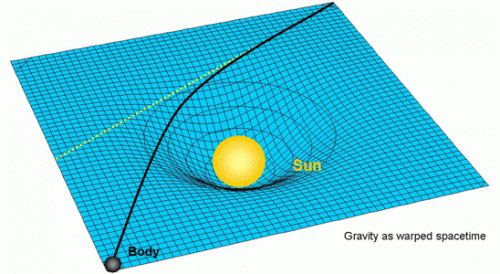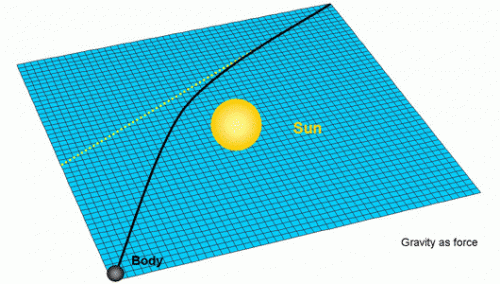-
Posts
720 -
Joined
-
Last visited
Content Type
Profiles
Forums
Events
Everything posted by juanrga
-
Stuckelberg and Feynman showed how antiparticles can be tough of as particles travelling backward in time. This interpretation is at the core of his diagrammatic approach to QED: http://prola.aps.org/abstract/PR/v76/i6/p749_1
-

WHO ? Today is the living Expert Scientist in Quantum Physics?
juanrga replied to Mike Smith Cosmos's topic in Quantum Theory
For several decades now, he and co-workers are trying to formulate a new quantum mechanics beyond the Copenhagen one [*]. This extension of ordinary QM is particularly suitable for quantum cosmology because does not require an external human observer neither requires a classical background as Copenhagen. This is research in progress: http://en.wikipedia.org/wiki/Consistent_histories [*] Notice that Feynman accepted the standard Copenhagen version of quantum mechanics and only developed a formulation which is entirely equivalent to the previous formulations: Schrodinger, Heisenberg... -

Re: Particles and their properties
juanrga replied to Dr.Bubafunk's topic in Modern and Theoretical Physics
Contrary to myth, such "non-existent objects" are not needed to explain Casimir experiment: http://prd.aps.org/abstract/PRD/v72/i2/e021301 Scientists are not forced to use virtual particles. -

Re: Particles and their properties
juanrga replied to Dr.Bubafunk's topic in Modern and Theoretical Physics
The key here is that the Casimir effect can be explained without even mentioning "virtual particles" http://www.mat.univie.ac.at/~neum/physfaq/topics/casimir -

WHO ? Today is the living Expert Scientist in Quantum Physics?
juanrga replied to Mike Smith Cosmos's topic in Quantum Theory
As said none, but the more close to Feynman must be Murray Gell-Mann. As said because he is wrong. Being popular for the general public does not mean being relevant for scientists. E.g. Brian Greene is very popular for layman due to over-hype on string theory, but he will not win a Nobel Prize (and his REAL contributions to physics are close to zero). At the same time, there are physicists who won a Nobel Prize, because their work was very important, and still they are unknown for the general public. He has contributed to a part of the Standard Model, but is very very far from being a top reference in quantum theory. Cox is well-known for his deep understanding of basic aspects of quantum mechanics http://blogs.scienceforums.net/swansont/archives/11081 http://motls.blogspot.com.es/2012/02/brian-cox-misunderstands-locality-pauli.html and so on... -

Is the Standard Model consistent with current observation?
juanrga replied to rwjefferson's topic in Quantum Theory
The Standard Model explains a broad set of particle physics experiments but cannot deal with: Arbitrary bound states. Mechanics (e.g. position and time are not observables in the Standard Model). Arbitrary many-body systems. Gravity. Unstable particles. Irreversible phenomena. Cosmology (e.g. dark energy). -

Re: Particles and their properties
juanrga replied to Dr.Bubafunk's topic in Modern and Theoretical Physics
A meson is not an antiquark. A meson is a particle composed of one quark plus one antiquark bound together by the strong interaction. A virtual particle is a mathematical representation of certain terms in the equations of some formulations of particle physics. http://www.mat.univie.ac.at/~neum/physfaq/topics/virtual -

WHO ? Today is the living Expert Scientist in Quantum Physics?
juanrga replied to Mike Smith Cosmos's topic in Quantum Theory
There is not Top Authority on Quantum Theory today and many names given here Penrose, Greene, Witten... are very very far. Penrose's views on quantum mechanics are wrong and rejected by 95% of physicists. Greene and Witten are string theorists (Witten is more a mathematical physicist) and only use a basic subset of quantum mechanics in their research works. This contrasts with Feynman, who not only used quantum mechanics, but developed one of the formulations: the path integral one. He was one of the Top Authorities on Quantum Theory then. His work was the basis for him wining a third of the Nobel Prize for physics. -
Buy physics textbooks and learn them at home or go to the university library and study them there. You would obtain a recommended list of books from the official physics course syllabus. After four/five years of self-study you would have the bare minimum of physics enough to start considering to become a future theoretical physicist. For becoming a theoretical physicist you will need specialised textbooks and monographs (very very expensive) and lots of papers (also very expensive) unless the university library provides you access without paying a full PhD course. Even if you are successful, 99% of theoretical physicists will not recognize you as one. Your work will be rejected from journals, conferences,... by political reasons. I know a guy who self-taught physics himself [*], has not PhD, and got very high recognition in a well-known physics forum, but he was banned recently by political reasons. I do not know if can post here the link after reading moderator note but can send it by PM. [*] He has a very good background level and knows some research areas of modern theoretical physics, but I would not call him a theoretical physicist and, in fact, his contributions to physics are zero.
-
You cannot because all your causality is defined with reference to that same time. You are part of the universe.
-
At contrary, your notation [math]m(0)[/math] is pedagogically misleading and, as a consequence, cannot be found in any textbook. Your [math]m(0)[/math] seems to indicate that mass is a function of speed, when it is not. [math]m[/math] in the formula [math]E^2 = m^2 c^4 + p^2 c^2[/math] denotes a relativistic invariant. It is the mass of the object at any speed, it is the mass when the object is at rest and it is the mass when the object is moving at half the speed of light.
-
Did you mean CERN? The search of the Higgs is not a "technological project" but a scientific one.
-
Excellent link!!!! Go to the page 318 of the chapter 27 (page 8 of the PDF file):
-
There is no difficulty to explain the EPR experiments and Bell results using a logical local theory without hidden variables. See the modern textbook cited above. The old mantra that says that we must abandon reality, logic, or locality is incorrect. Regarding Bohm old ideas, not only there is no real "quantum potential" in nature (precisely I am now writing a paper where I criticize this aspect of Bohm), but that the old concept of "quantum potential" is even deprecated in modern Bohmian mechanics
-
If you go back and read my post #25 you would check that I did not comment/object on the two first phrases of your post, because both were on-topic.
-
I do not know what do you mean by "as-yet-unverified advanced physics". I mentioned here the non-geometrical approach to gravity, which is taught to students (see Feynman lectures on gravitation) and used by astronomers and astrophysicists to make predictions about gravitational phenomena. The geometrical picture given by GR is only a formulation of several possible. The geometrical formulation is the more popular, because it is the older and the simpler, but in more advanced applications we use other formulations. Advanced courses in gravitation deal with those formulations. General public does not know those advanced formulations of gravity, but if someone is asking us about alternatives to "warped spacetime" (as someone did in this thread), we would inform him about the alternatives such as the non-geometrical approach, and provide to him literature, as I did when cited Feynman lectures on gravitation; instead of saying to him incorrect stuff as several posters did. This is not characteristic of gravity, but the rule in physics and would be the rule in SFN. For instance, the wavefunction approach to QM is only a formulation of several possible. The wavefunction formulation is the more popular, because it is the older and the simpler, but in more advanced applications we use other formulations. Advanced courses in quantum theory deal with those formulations. General public does not know those advanced formulations of quantum theory, but if someone is asking us about alternatives to wavefunctions, we would inform her/him about the alternatives and provide literature on those alternatives. The same about electrodynamics, thermodynamics...
-

Guideline for using U and H in thermodynamics
juanrga replied to jasoncurious's topic in Homework Help
Sorry, but what I wrote above is plain wrong. Enthalpy is obtained from internal energy when the variable volume V is substituted by the variable pressure p. U=U(S,V,N,...) H=H(S,p,N,...) Enthalpy is useful in situations when volume is variable or cannot be easily controlled, but pressure can. -
I repeat: "You would not hijack this thread with the same nonsense." If you have some 'new argument' about your opinions on reality use the speculations forum specifically devoted to your opinions. This quantum theory thread is about entanglement. This is not the place for reading/discussing your nonsense about photons, quarks, electrons...
-
Ok It means that both the experiment and the theory describing it do not use/require any nonlocal influence. There is no collapse of the wavefunction associated to the Schrödinger equation, but if even if you consider a description with a collapse beyond the Schrödinger equation, the collapse continues without transmitting any information or causality neither FTL nor in any other way. This is nonsense. There was a long thread in speculation forum where it was shown that your 'opinions' are unfounded and based in a misunderstanding of (i) the scientific method and (ii) quantum theory. That thread eventually died because you were unable to answer the critics. You would not hijack this thread with the same nonsense.
-
One thing is to give a superficial presentation of a basic formalism, omitting details or more advanced stuff, and another thing is to say plain wrong stuff in a science forum. My complain here started when one poster asked for a description of gravity that does not use warped spacetime and several replies said him that "gravity is warped spacetime" and cannot be explained in any other way. This is false. One poster even said that light bending only can be explained by warped spacetime because, he said, "photons are massless". That is also wrong. Light bending in flat spacetime is perfectly explained using the non-geometrical approach discussed in Feynman lectures on gravitation. Who said the contrary? What approach? I do not know why you repeat essentially what I have said in #65.
-

Guideline for using U and H in thermodynamics
juanrga replied to jasoncurious's topic in Homework Help
U is useful when working with variables (S,V,N,...). H is useful when working with variables (T,V,N,...). Precisely enthalpy is obtained from internal energy when the variable entropy S is substituted by the variable temperature T. -
Yes you cited a website for the general public, whereas I cited the lecture notes on gravitation by Feynman and coworkers http://www.amazon.com/Feynman-Lectures-Gravitation-Frontiers-Physics/dp/0813340381 which includes a foreword by John Preskill and Kip S. Thorne (yes the same Thorne of the MTW textbook) praising the modern approach by Feynman. As correctly emphasized in the above reviews of Feynman lectures: There is one part of my previous message that it seems was not entirely clear. The non-geometrical approach has a classical description which is derived from the graviton theory. This classical description describes the same phenomena than GR and, in fact, several astrophysical predictions regarding pulsars were first made by the non-geometrical approach. Gravity is described by a warped spacetime only in the old geometrical approach and, as emphasized by Feynman in his textbook, the geometrical approach is neither needed nor fundamental for physics.
-
Did you read the full quote from his textbook given above? What part of do you believe support the claim that non local effects are indicated by experiment? Regarding the 'bare' compatibility of quantum theory with SR, the mix of both is quantum field theory. This is a local theory, as shown in any textbook on QFT.
-
It is untrue that one event at one location affects in non local fashion another event. There is no "spooky action at a distance" in quantum mechanics. A rather good study of all this is given in the textbook Consistent Quantum Theory by Robert B. Griffiths: Unsurprisingly, the chapter 23 is titled "Singlet state correlations". As explained before in this thread, the quantum state is not given by a mere tensor product, there are correlations, between the measured variables.
-
Some remarks made above by several posters regarding the nature of gravity are not correct. As Feynman states in his lectures on gravitation: The geometrical formulation interprets gravitational phenomena in terms of spacetime curvature. This is the GR approach reported above by several posters: However, the modern non-geometrical approach interprets the same phenomena in terms of a force mediated by the interchange of gravitons: Notice that the spacetime is flat in the non-geometrical approach. I would add that the graviton approach is more fundamental and that the geometrical approach of GR (recall that GR is a classical theory) is only an approximation; somehow as geometrical optics is an approximation to a non-geometrical theory of photons.



